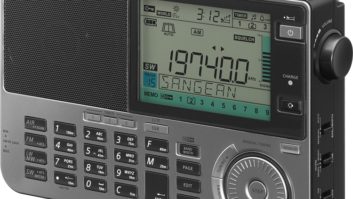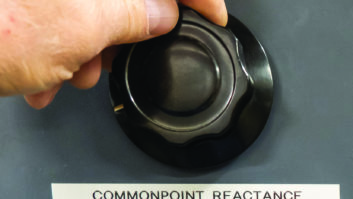This is one in a series of photo features from the author’s collection. See past images here.

Today’s radio folks have it easy when it comes to remote broadcasts. Just grab a wireless codec and microphone and head out the door. But it wasn’t always so.
In the early years of radio, line amplifiers weighed hundreds of pounds and ran from external storage batteries. Even the microphones themselves needed their own power supplies. Also, broadcast phone lines had to be ordered days or weeks in advance. To accomplish a remote broadcast, many hours of planning and equipment installation by several people were required.
Even in the 1960s, studio equipment was still bulky, and few specialized remote products were available. In this undated photo, Jim Boynton, the production manager of WILZ(AM) in St. Petersburg, has his hands full as he heads out the door. But the items of particular interest to our eyes in this photo today are the two iconic pieces of broadcast equipment Jim is carrying.
The Ampex 600 “portable” reel-to-reel tape recorder was a mainstay in the radio industry for two decades. It was reasonably priced, fit easily into a crowded control room and at “only” 28 pounds could be hauled out of the station for on-the-scene recordings.
The model 600 was introduced in 1954. It ran at a single speed of 7-1/2 inches per second, full-track mono, and played 7-inch tape reels. Its audio quality was excellent — 40 to 15,000 Hz — and it was ruggedly built and easy to use. Over the years, 80,000 Ampex 600s were manufactured in several configurations, including the stereo model 602 and the 620 portable amplifier/speaker.
Its main drawback was its difficulty of editing because of limited head access. By comparison, it was a lot easier to cue and splice tape on a Magnecord PT-6 — the other widely used radio tape recorder of its day.
The second beloved item in Jim’s hands is the 77-DX ribbon microphone, which was manufactured in various versions by RCA from the late ’40s until 1973.
Even today, 40 years after production ceased, the 77 series is still the stereotypical image of a professional microphone. Its smooth sound quality, adjustable pickup patterns and stylish appearance made it the perfect studio microphone. Today, original specimens are sought after and highly prized by both collectors and recording engineers, and often sell for even more than the best modern microphones. AEA and a few other companies are again producing new ribbon mics based on the original RCA designs.
A ribbon microphone derives its name from the corrugated metallic ribbon, which is suspended between two poles of a permanent magnet. When sound air currents flow past the ribbon, it causes an electrical current to flow through the ribbon. This is sometimes also referred to as a velocity microphone because it relies on the velocity of the airflow across the ribbon, instead of the generation of sound pressure against a diaphragm.
WILZ today is known as WRXB(AM) Praise 1590. Jim Boynton is now the program director of KGUD(FM) in Longmont, Colo.
John Schneider is a lifelong radio history researcher. Write him at [email protected].












